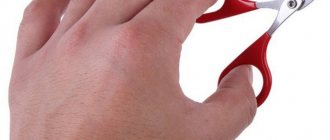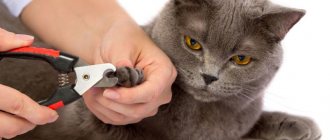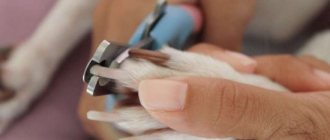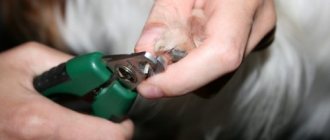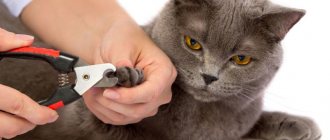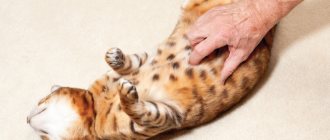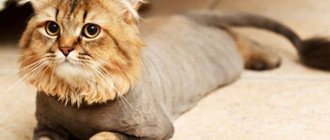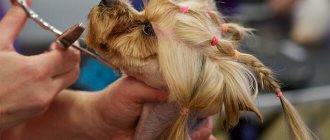Our fluffy and gentle pets have natural reliable protection. These are strong, sharp little claws. They can cause serious injuries to cats, which causes concern for many owners, especially if there are small children in the house. Special microorganisms (Bartonella bacteria) nest on the claws of cats, which, when released into the bloodstream when the skin is damaged, can provoke a disease - felinosis, cat scratch syndrome, benign lymphoreticulosis, cat scratch fever, Mollaret granuloma. Under all these complex and long names lies a very unpleasant infectious disease with inflammation of the lymph nodes, fever and severe intoxication. The disease requires the use of antibiotics for treatment.
Considering the possible health risks, as well as the passionate love of cats for scratching new expensive furniture, fresh wallpaper and expensive carpets, many owners come to the conclusion that something needs to be done about their pet’s claws. In the best case, special scratching posts are purchased for pets; in the worst case, they decide to have their nails cut or completely removed.
Before you make potentially dangerous and cruel decisions, you need to understand why cats need claws and what role they play in their lives.
Why take care of your claws?
Any cat itself maintains its claws in normal condition. She sharpens them regularly, often on furniture or carpet. If you don't take any measures, a sofa, armchair or wallpaper will quickly turn into rags. Ungroomed claws damage not only furniture. A cat can run wildly across the carpet and get its claw stuck. In a panic, she will easily rip it out, which will cause her great pain. If you have a cat in the house, it is important to monitor not only its health and fur, but also the condition of its claws.
What not to do
It is also important to consider that some manipulations can be harmful to the health of the pet.
Do not do it:
- Place the cutting tool parallel to the nail plate, as this can lead to delamination.
- Skip the next manicure session.
- Trim an animal's claws if it is nervous, breaks out, or is aggressive. In such a situation, you can accidentally hurt or injure your pet.
- When pruning, do not touch the pulp, because bleeding and subsequent improper treatment can cause an inflammatory process.
- Carry out the procedure with blunt instruments. This is fraught with problems in the form of delamination or breaking of the claw.
- Plan several different activities related to pet hygiene for one day. This can negatively affect the cat's psychological health.
Scratching post - the main accessory
It is important for cats to sharpen their claws regularly. This is how they remove the top chitinous layer, under which the young claw hides.
Animals that walk outside sharpen their claws on trees. Domestic cats choose some kind of “victim” for this: a sofa, walls, carpet or chair. To protect your furniture, purchase a scratching post: one or several, according to the number of rooms in the house. Pet stores offer a huge selection of these accessories. Which one to choose? Take a closer look at your pet. If he likes to tear up the sofa, choose an upright model. If your cat likes carpet, buy a horizontal scratching post. There are also special overlays for furniture, scratching posts, houses, etc. You can simply nail an ordinary board if such a design decision does not bother you.
Haircut instructions
The procedure for trimming nails is not simple and consists of several stages that require certain preparation.
First you need to choose the right time. It is better if the cat is sweetly dozing or in a good mood. The position of the cat should allow the owner to fix it without causing discomfort or pain.
The claws of the tailed furry need to be treated with an antiseptic to avoid dirt or dust getting into the wound.
Now you can begin the procedure itself. It is necessary to expose the claws by pressing on the central pad of the paw. A bare claw will help you clearly see the pink part with blood vessels and nerve endings and determine the location of the cut.
Only the transparent part of the claw is trimmed . If you cannot determine the location of the cut - the border with the pink pulp is not visible - you need to cut off 1 or 2 mm from the rounded tip of the claw.
It is very important to hold the tool correctly towards the growth of the claw and make the cut at the required angle so that the edge of the claw remains pointed. Cutting at a different angle may cause nail separation or pulp damage.
When grooming, it is important not to forget to trim the claw on the fifth toe of your pet’s front paws. This finger is often forgotten, which is why it can cause pain to the cat by digging into the pad on the paw.
How to train a cat to use a scratching post
Training is best started at an early age. But adults also make good friends with the new “simulator”.
To stop an animal from damaging furniture, you can spray it with water during each act of vandalism. You can also rub the furniture with orange or lemon peel - cats cannot stand the smell of citrus fruits. If your cat flatly refuses to approach the scratching post, rub the surface with catnip or a spray based on it. A cat's reluctance to sharpen its claws where they should be may be due to an unsuitable scratching post. It may be too loose or smooth. Sometimes it is worth changing several accessories to find one that your pet will like.
Required Tools
Pet stores offer a wide range of special tools to properly trim your cat's nails.
Nail clippers . These include special pruning shears, reinforced wire cutters, or nail clippers. These are all mechanical tools with a round claw cutout. But they all have one big drawback - the owner who is cutting the claw has difficulty seeing the length of the claw and the place from which it needs to be cut off.
Guillotine trimmer . This is a modern device, easy to use. With its help, the cut is made as rounded as possible. But there is also a drawback here - a working trimmer makes noise, which can frighten an already fearful pet.
Grinder . This is a sharpening stone with an abrasive coating that can be used to painlessly sharpen a claw and polish it.
Regular manicure scissors . But they must be used with caution and only for trimming soft tissues in kittens. This tool is not at all safe for adult cats.
It is important that all these tools are well sharpened and their handles are covered with non-slip material. Before use, the instrument must be treated with a disinfectant.
You will also need an antiseptic to stop the bleeding if a wound forms.
Top 5 Misconceptions About Cats You Believed
Cat manicure
You need to trim your nails yourself or at a grooming salon in the following cases:
- The cat scratches household members or, even worse, children.
- The animal spoils the furniture and does not want to get rid of this bad habit.
- To prevent claws from growing into the fingertips of older pets.
- Before grooming a cat.
Important: if a cat walks outside, its claws cannot be trimmed. In case of danger, the pet will not be able to escape on the tree.
The procedure requires a special tool – a nail clipper. Ordinary scissors will not work - the claw will only peel off and not be cut off. These can be cutters with a limiter, scissors with rounded slots, or guillotine pliers.
How many claws does a cat have on its hind and front paws?
Mammals have five-fingered limbs. The cat differs from other mammals in that it has 18 toes, each with one claw.
How many fingers does a cat have, so many nails?
The number of claws on the front and hind limbs is different. There are five fingers in front - ten claws. The hind ones have four fingers, which means eight claws.
Four fingers with claws are located in one row, and the fifth with a claw is slightly protruded to the side, which allows it not to touch the floor surface when walking. The fifth finger is vestigial.
How to trim claws correctly
If you trim the claws correctly, the animal will not be hurt. It is important not to touch the living part of the claw with nerves and blood vessels. That is, you can only cut off the transparent part.
For the procedure, take the animal, press on its paw so that the claws protrude. Using gentle, confident movements, cut off the transparent part.
If the claws are dark, the living part is not visible. In this case, you should cut off the edges millimeter by millimeter, monitoring the pet’s reaction. Remember that on the hind legs the claws are shorter, which means there is less dead edge.
You need to be calm during the procedure. The cat will sense your excitement and perceive the haircut as a threat. If she does not want to sit quietly, it is better to carry out the procedure together. You need to encourage the animal in every possible way and praise it for good behavior.
Nails should be trimmed approximately once a month. But everything is individual. Inspect the pads regularly: if the claws have grown, repeat the procedure.
Anti-scratch for cats
Applications of the product
There are 4 types of caps according to their size, presented in the table:
| Size | Cat weight, kg |
| XS | 0,5—2 |
| S | up to 4 |
| M | until 6 |
| L | from 6 |
The caps are attached using hypoallergenic glue, and they can be put on by an animal whose claws have already become stronger.
It is better to carry out the procedure on a cat whose nails have already become stronger. Anti-scratch guards are attached to retractable claws using glue. They are worn on the hind and front legs. It is bought in veterinary stores, because it is hypoallergenic and suitable for all pets. Before starting the procedure, you should try on the product: if it is too large, then you should cut it off. Afterwards, the cat’s paws are massaged and dirt under the claws is cleaned. First, a small amount of liquid is applied to the surface of the nail, and then the cap itself is put on. At first, the kitten will try to get rid of the anti-scratches, but after that he will get used to them.
Alternatives to Nail Trimming
Many owners, tired of dealing with cat hooliganism, resort to a last resort - amputation of claws (onychectomy). During this procedure, the animal's claws are removed along with the finger bones. This is a very traumatic operation. Physical recovery alone will take six months. But the cat will never recover morally.
Without claws, the animal feels vulnerable. Coordination of movements is impaired. Many pets adapt, but many do not and die.
Claw amputation is prohibited in many EU countries and is considered cruelty.
There is another operation - tendectomy. During it, pieces of tendons are cut out. After this, the cat cannot release its claws. The operation is also crippling, leading to injury due to the inability to maintain balance.
Why you shouldn't declaw your cat
Declawing surgery, or soft paw procedure, also known as onychectomy, is prohibited in some countries. It is considered animal cruelty and for good reason. This is an extremely painful and unnatural operation that should not be performed for the following reasons:
- extremely long and painful recovery period;
- the animal remains disabled for its entire life, since during onychectomy the terminal phalanx of the finger is removed along with the claw;
- high risk of complications (infection, suppuration, etc.) and subsequent death of the animal;
- the cat's behavior may change after surgery;
- the absence of claws impairs the cat’s sense of balance and mobility;
- ignoring the tray, because without claws a cat cannot fully rummage through the litter as before.
Covers for claws
To protect furniture and people from cat claws, soft caps made of silicone or vinyl (“anti-scratch caps”) are used. They are glued to the claw with special glue.
But such cases are also not safe. The secretion of secretion from the glands of the fingertips does not stop. It begins to accumulate under the “anti-scratch”, which can lead to inflammation.
Also, cats often tear off the covers with their teeth and eat them. It is better to use such overlays for a short time. For example, until the baby grows up and understands that you cannot pull the cat’s fur and tail.
So, as you can see, the best solution for caring for the claws of cats and cats is a scratching post. It is necessary to teach a kitten from infancy not to scratch furniture and people, and then extreme measures will not be required.
How to calm your pet during a haircut?
- The main thing is for the owner to remain calm, or at least the appearance of it. All pets perfectly read emotions and if a cat feels that the owner is nervous or afraid, then she will immediately intercept these moods and it is unlikely that anything will be done with her.
- Some cats calm down by listening to calm music. Therefore, you can try putting it on, maybe it will calm a cat, or maybe at least a person.
- You can use products with cat pheromones, of which there are a lot on the market at the moment.
- Treats should be given to a cat as a reward, not as a bribe. A cat may know that a person has a treat, but it should receive it only after allowing at least one claw to be trimmed.
- After the cat has been rewarded several times for each claw, it is time to increase the interval, rewarding her only for every second, third claw, and then only for every paw.
IMPORTANT! The cat should be held without using force. A variety of violent movements, grabbing the scruff of the neck, and the like can only irritate the cat even more, and at the same time lead to a loss of trust in people.
It is difficult to find a feline who would enjoy trimming their claws. The best outcome is if during this process the cat does not scratch everyone nearby and then hides under the sofa for a week. But following the tips above will help make nail trimming a more relaxed experience.
The material was prepared by specialists from the veterinary clinic of Daria Sukhova.
If you were unable to trim your cat’s claws at home, call +7 (3452) 66-21-29 or come to our veterinary clinic.
If a vessel is hit
If the cat gets nervous while trimming its nails and constantly tries to jerk its paw, a blood vessel may be damaged.
On a note! Having noticed blood on a claw, you should not panic and invent non-existent horrors - up to and including the development of gangrene in the animal.
Nothing like that will happen - the injury is equivalent to a small cut on a person.
If bleeding does not stop, contact your veterinarian
But it is necessary to prevent germs from getting into the wound - to do this, just rinse it with hydrogen peroxide or any alcohol-containing product. If the bleeding does not stop within 40-60 minutes, you should contact your veterinarian.
What to do if your cat resists
If your cat won’t let you cut her nails, you can try to accustom her to this procedure gradually, the main thing is to be patient.
Try a few simple tricks:
- If your cat doesn’t have enough patience for a long time, start small. To begin with: cut two claws and release the pet, not forgetting to praise. Then cut off more, and increase the number of toes until you have processed all the paws.
- Wait until the cat has no desire to resist when she has eaten and becomes sleepy.
- Try trimming nails while your cat is sleeping.
- If your cat becomes stressed due to the procedure, you can try giving him sedatives using natural herbs, for example, “Cat Bayun”.
- If you catch a kitten in a playful mood, you should postpone claw trimming until the kitten becomes less agitated.
We hope that our article will help you develop an effective strategy for trimming your pet's nails. If your cat won’t let you get close to his manicure with scissors or has an aggressive character, then we recommend reading our article about silicone anti-scratch pads (harmless to the pet’s body and a solution for responsible owners). Share with us and our readers in the comments: what tricks do you practice when trimming your cats’ claws?
How often should the procedure be performed?
- Sedentary lifestyle or illness. If the animal is not very active, then it cannot sharpen its claws on its own.
- Room contents. Pets are unable to properly care for their nails. If a pet has the opportunity to walk outside, then it is able to cope with its problem on its own.
- If you have small children. A child and a cat do not always get along with each other. Often the animal can release its claws. Therefore, it is worth regularly giving your cat a manicure.
- Wash your hands well and sterilize the instrument.
- Hold your pet firmly and press on the paw pads until the claw appears.
- The device must be directed at right angles to the desired nail (direction from top to bottom).
- If the animal has a light-colored claw, then it needs to be trimmed within 1-2 mm of the pink area. For cats that have pigmentation, trim 1-2 mm from the tip of the nail so as not to damage the capillaries. If the pet has dark claws, they are trimmed in stages to avoid bleeding.
- Trim the claw in one motion.
- Sand the cut area with a nail file and treat with an antiseptic.
You should not keep your cat in an awkward position for a long time, as this can make her nervous. It is important to know that if a capillary was touched during the procedure, then a bandage or cotton wool moistened with hydrogen peroxide must be applied to it. In addition to this remedy, you can use Chlorhexidine. If you cannot stop the bleeding, you should contact your veterinarian. But usually such manipulation, if you have the proper experience, is quick and painless.
Owners of the Persian or Siberian cat breed will need a special hair clipper. These animals have a lot of hair near their paw pads. They prevent safe nail trimming. If your pet is frightened by the noise of the device, you can cut the hair using scissors. After the procedure, you can treat your pet with his favorite treat. Also, the animal must be praised for its exemplary behavior during the procedure.
On average, a domestic cat needs trimming once a month. If a young animal lives in the house, then a haircut should be done once every 2 weeks. At this age, claws grow faster than those of older cats. You should not skip this procedure, as the pet will get used to it very quickly and the owner will have to accustom him to the unpleasant manipulation again. If an animal is to compete in a competition, its claws must also be trimmed. Otherwise, the cat may be excluded from the competition.
Here you should take into account the individual characteristics of each pet, for example, the rate of growth and lifestyle. Active cats grind off some of their claws on their own, but lazy sofa kings do not. Consequently, the latter need manicure procedures more often. Observe your cat and choose the optimal trimming frequency.
The cat's claws are trimmed
The frequency of performing this procedure is strictly individual. The owner of the animal must find out how quickly the cat’s claws grow and create an individual schedule for the procedure. Some cats go through it no more than once a month, others have to go through a haircut 2, and sometimes 3 times a month.
If a cat not only lives at home, but also often walks outside, then, most likely, his claws will have to be trimmed much less often. They will wear off naturally. But not so effective that you can completely abandon the haircut.
The claw has an outer hard shell, under which the pulp is hidden. It contains blood vessels and nerve endings. The pulp occupies most of the claw. It cannot be damaged. The keratinized part is cut off. This is just a few millimeters at the very tip of the nail.
To avoid mistakes, you must first examine your pet’s claws in the light. They are well translucent and thanks to this you can see the border of the pulp of the keratinized tissue. It is along this border that the claws need to be trimmed.
Naturally, before starting the procedure you need to prepare the appropriate tools.
- Special scissors called nail clippers. They are made of durable stainless steel and are specially designed for this purpose.
- Guillotine trimmer. It is better for beginners to use this device. It is very easy to use and completely safe for your pet.
- Hard nail file. You can use a regular nail file from a manicure set.
All instruments must be disinfected before use. No need to boil. It is enough to treat the tools with alcohol.
It would also be useful to prepare cotton pads, hydrogen peroxide and an antiseptic - chlorhexidine. These items will come in handy if the owner touches the pulp.
In addition to the four working claws, with which the cat catches and holds prey, and tramples on its owners (by the way, massage-stomping is another reason to trim your pet’s claws on time - otherwise a pleasant trampling threatens to turn into a painful ordeal), the animal also has a fifth claw, which must be cut off.
Due to anatomical features, namely its location too high on the paw, the fifth claw cannot be sharpened naturally by walking on the ground or asphalt. In addition, it is located on the inside of the animal’s paw, so it cannot be ground off by wood or scratching posts.
The fifth claw is an invisible front of work that must be done before or after trimming the main claws. The main thing is not to forget about its existence, since the grown fifth claw can cause pain to the animal when walking.
Claws should be trimmed as they grow, approximately once every two to three weeks. This procedure should not be skipped, otherwise cats will quickly wean themselves off it and the owner will have to re-accustom the cat to trimming its claws.
An exception may be in cases where the pet is sick or is under stress.
Owners whose cats participate in exhibitions or competitions before such an important event must trim their pet’s claws, otherwise it may be disqualified.
How often should I trim my hair? It all depends on the individual characteristics of the cat. Experts in the field of felinology strongly recommend accustoming a meowing creature to this procedure from the age of a kitten. Then in “adult” life the pet will treat her more calmly.
You can accustom a baby kitten to a haircut after 1 month of life. Let us warn the owners: “Is it possible to trim a cat’s claws at such a young age?” It is possible and necessary! After all, the sooner a pet gets used to using a nail clipper or scissors, the faster and more painless the grooming process will be in adulthood. But it is up to the owner to clearly determine at what age a cat can be declawed through circumcision. And if the cat is too weak by 4 weeks of life, it is better to abandon the procedure for a while.
There is no point in carrying out the procedure earlier than 1 month. Firstly, the claws of newborn kittens are still too tender, unable to cause pain to either the mother cat or a person. Secondly, kittens under 1 month are not yet so active and spend most of their time on a cozy bed, drinking mother's milk and dreaming. Thirdly, the baby can easily damage the blood vessels located in the thickness of the small claw.
If for some reason an adult cat appears in the house, you can accustom it to grooming too. True, with a mature individual it will be a little more difficult (the cat can break out, hide, bite or scratch the owner).
- Take care of hand and instrument hygiene;
- Calm down, talk to the cat quietly and calmly;
- Place the purr in your arms, taking the tool (claw clipper) in your working hand;
- With your free hand, grasp the cat's paw, pressing on the pads of the fingers so that the claws extend to their full length;
- Holding the nail clipper perpendicular to the claw, cut off its curved tip without affecting the blood vessels;
- If necessary, file the claw with a nail file;
- Trim the claws on all the cat's toes;
- If the pulp is injured, treat with hydrogen peroxide;
- Praise your patient friend by giving him a treat.
